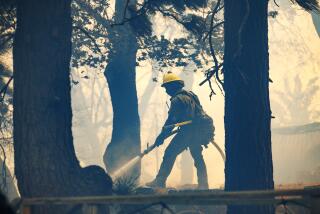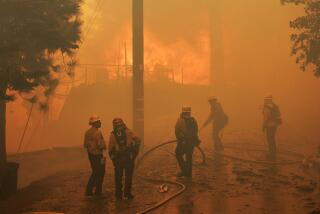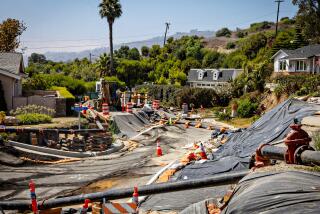At-Risk Areas Brace for Rain
While Southern California was spared from heavy downpours forecast for Tuesday, a handful of San Bernardino County residents whose properties were declared a potential “high risk” for deadly floods and mudslides scrambled to fortify their homes before other rainstorms sweep through in the weeks ahead.
Two of the 15 people killed in a Christmas Day storm were washed away from a KOA campground in Devore that the California Geological Survey had identified as a high-risk area for the loss of life and property.
Residents of six other high-risk properties in Lytle Creek and northwest San Bernardino County said authorities had warned them of the danger. But the residents said that the warnings seemed casual, and that there was no recommendation to evacuate.
“I gotta tell you [the warning] was pretty low-key,” said Cathy Smith, a resident and employee of Bonita Ranch RV Campground, located at the foot of a steep, bare hillside in Lytle Creek that was blackened by the wildfires of October and November.
Despite the break in the weather, weary crews did not resume searching for the body of 12-year-old Edgar David Mesa, the last unaccounted-for member of a group of family and friends who had gathered for an unauthorized Christmas celebration at the St. Sophia Camp in Waterman Canyon. Fourteen people were swept away when a flash flood of mud, boulders and logs swept through the camp.
Up to 3 inches of rain had been forecast for the mountains Tuesday, but the showers missed the flood-ravaged areas, said Ryan Kittell, a National Weather Service specialist. The rest of the week is forecast to be dry except for a chance of showers Friday.
“The storm took even more of a turn out to sea,” Kittell said. “It’s raining pretty heavily, but it’s raining where nobody lives.”
After the Old and Grand Prix fires ravaged the San Bernardino foothills and mountain areas, the California Geological Survey and the California Department of Forestry and Fire Protection surveyed the charred areas and nearby communities and found 28 locations that faced at least some risk to life or property -- in floods or mudslides -- when rain hit the area.
Most of the locations at highest risk sit below steep, denuded slopes studded with loose rocks. Some of the homes are located at the openings of well-developed alluvial fans, meaning water would be funneled into the homes. Only a few of the properties have protections from sliding mud.
Although officials with the state geological survey are not obligated to warn property owners and have no enforcement power, agency staff told residents about the danger whenever they found people at home during the inspections. The staff also wrote letters to residents at all 28 properties facing a risk of damage, even if it was considered low.
“I couldn’t sleep at night if someone was killed because I did not give warning when I saw a problem,” said Tom Spittler, a senior engineering geologist with the California Geological Survey, who oversaw the reports.
The state is required only to send the reports to the Redlands field office of the Natural Resources Conservation Service, a part of the U.S. Department of Agriculture.
Spittler doesn’t know how many residents took his advice. The state is planning to send a staff member back to San Bernardino County to check.
At least some owners seemed to take the state’s advice to heart.
When one of Spittler’s staff members, John Schlosser, made a round of calls Friday, he talked to two people on the at-risk properties. Among others, Schlosser reached a representative at the Deer Park Nudist Resort on Glen Helen Road in Lytle Creek, a low-risk site, who told him they had put sandbags around their water tank after they received the initial warning.
As the state workers were doing post-fire inspections in November, employees of the Natural Resources Conservation Service were revisiting some of the sites and finding other danger zones. Whenever service staff visited a site, they recommended where to place sandbags, which windows to board up and how to direct water in a safe fashion, District Conservationist Jim Earsom said.
Inspections on Nov. 7 identified the KOA campground in Devore as a major problem. Earsom said his staff talked to the manager about the flood danger and suggested “major measures” for the campground.
He had no specifics Tuesday about the warning, saying the staff member who talked to camp manager Janice Stout-Bradley was on vacation. Stout-Bradley was killed in the flash flood.
One of the campground owners said he never received the warning.
“I’m kind of confused,” said John Gordon. The manager “was an extremely conscientious person, and if there was an order, or any inkling of it, there was no doubt in my mind that she would have followed it.”
Gordon said that Stout-Bradley had called several local law enforcement agencies the morning of Dec. 25 and that no one told her to evacuate. Gordon said he called the Sheriff’s Department, which referred him to the fire department, about possible dangers.
About 15 miles away at the Bonita Ranch RV Campground, state officials arrived in November to warn that some of the motor homes were in danger of being hit by a mudslide.
In response to the warning, the campground manager persuaded motor home owners to move their RVs to the side of the campground farthest from the hillside. Still, Smith said, the warning didn’t seem dire.
“They didn’t point out the scope of the situation,” she said.
A state Geological Survey report dated Nov. 11 said a 300-foot slope -- with 90% of its vegetation burned -- looks down on the campground. The burned slope includes outcroppings of rocks as big as 5 feet across that are in danger of tumbling down onto the trailers and homes.
“If a large rock ... comes down the slope, it may not be feasible to construct a fence or wall strong enough to keep it from hitting a trailer or structure located near the base of slope,” the report stated.
The state survey also assessed the risks faced by the home of Smith’s neighbors, Gerald and Delories McCullah. They were told their two-story home was rated a high risk for the loss of life and property, and were warned of a potential mudslide. But they were not told to evacuate, they said.
“They said we don’t have to worry,” Delories McCullah said.
She said the survey representatives suggested the couple build a culvert using telephone poles to divert mud and water away from their home. Instead, the McCullahs hired two workers to build a retaining wall out of rocks and sandbags.
In the city of San Bernardino, the single-story Spanish-style home of Mark and Laura Mollet also was classified as high risk. The Mollets moved into the house just two weeks ago. The fires stripped the hillside behind the home of all vegetation.
The couple said they never received a warning from the geological survey, but city officials told them the house is among the most vulnerable in the city.
“We certainly knew there was some possibility of danger with the mud,” Mark Mollet said. “We did not realize the extent.”
During normal conditions, water is guided down the mountain, along two drainage paths, onto a road, and eventually into storm drains. But on Christmas Day, the muddy water breached a reinforced drainage path and overran their backyard with 3 feet of mud.
They ended up spending $2,800 to haul the mud out of their backyard and reinforce the drainage.
The Mollets have spent the days since then preparing for the next round of winter weather. About 150 sandbags are strategically placed throughout the property to keep their home dry. They met some of their neighbors for the first time when they came over to help lay sandbags.
“We’re just preparing. We’ve been praying a lot,” Mark Mollet said. “I’m a minister, and I believe in the power of prayer.”
Times staff writers Lance Pugmire and Janet Wilson contributed to this report.
More to Read
Sign up for Essential California
The most important California stories and recommendations in your inbox every morning.
You may occasionally receive promotional content from the Los Angeles Times.












